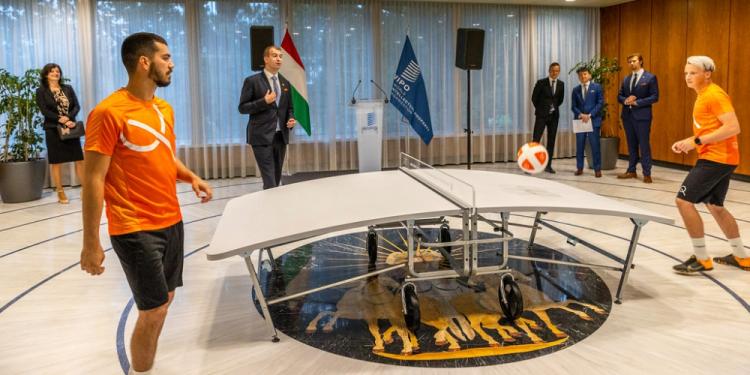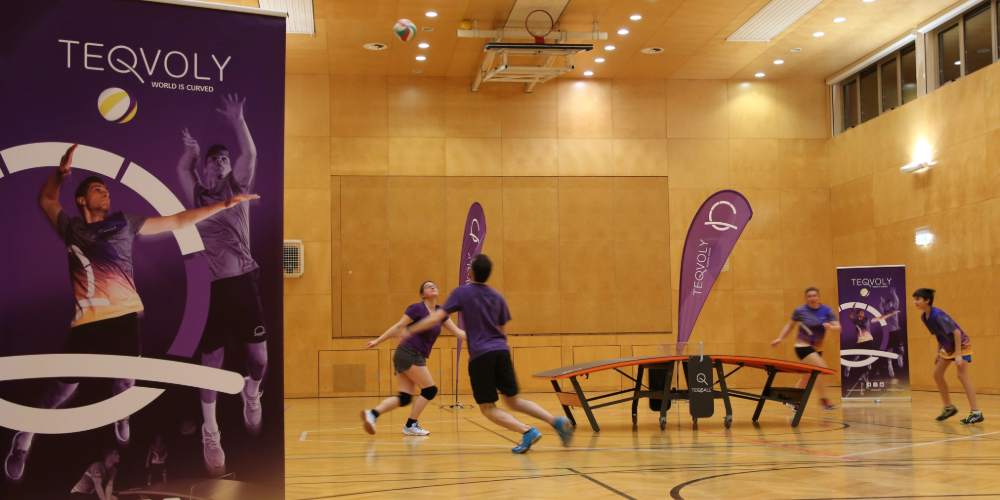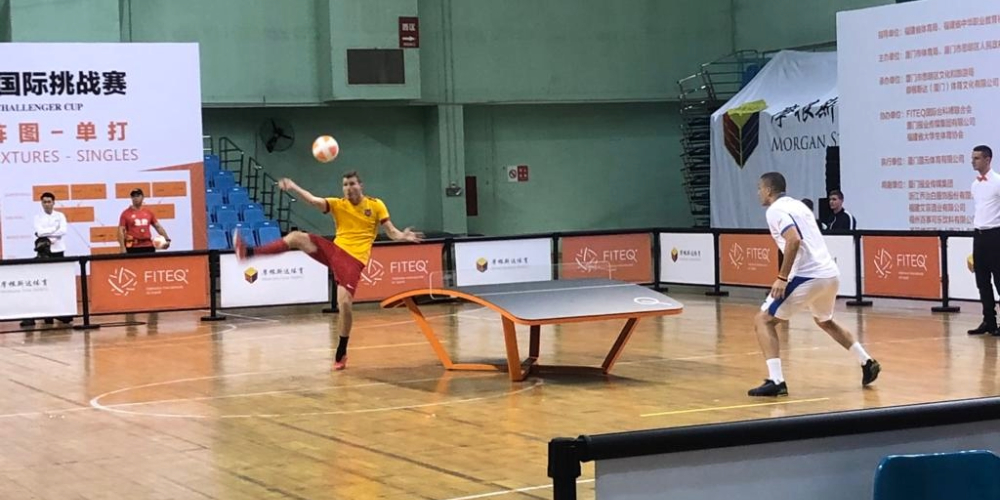A Complete Beginner’s Guide To Teqball
Posted: January 10, 2024
Updated: January 10, 2024
Like a bizarre cross between table tennis and football, the new sport of Teqball is taking the world by storm. In fact it's the fastest growing sport, with fans and players enjoying matches around the globe. Since thier beginnings in 2012, the Hungarian developed game has become a sensation, with the promise of acceptance to the Olympics just around the corner.

There are diverse pathways to enhance football skills. Tactical acumen thrives in structured 11-a-side league football, while technical finesse finds its challenge in the intensity of 5 or 7-a-side matches. Moreover, an unconventional avenue for talent refinement has emerged recently: a football-associated sport that fosters quick reflexes, aerial mastery, deft first touches, and precise close-range passing within a competitive format. Notably, this game has garnered acclaim from some of the most prominent figures in global soccer.
This game is Teqball, a ball sport embraced by major clubs and renowned personalities in world football due to its manifold advantages. In today’s Gamingzion.com article, we delve into a comprehensive exploration of Teqball—its intricacies, historical trajectory, and the driving forces behind its meteoric rise to popularity. Once you’re feeling competent about how the game functions, along with having seen some of the world’s top players in action, then why not head over to one of the best Teqball online sportsbook sites in the US, 22Bet Sportsbook. Here you’ll discover some of the most varied Teqball betting markets in the world.
What Is Teqball?
Teqball, a unique ball sport, takes place on a curved table amalgamating elements from table tennis, football, and Sepak Takraw—a Malaysian sport resembling “kick volleyball.” Unlike Sepak Takraw, Teqball confines play to a smaller area, focusing on a 3-metre long, 1.7-meter-wide Teqball table. Players engage in 1v1 or doubles matches, akin to table tennis, aiming to outmanoeuvre opponents by striking a football across the table. Similar to football, players employ any body part except arms and hands to manipulate the ball.
The game’s essence lies in teams executing a maximum of three touches to return the ball against the table to the opposition. In a doubles match, tactics might involve head control, followed by a chest lay-off, and then a volley, making it challenging for opponents to counter. Points accrue when the opposition fails to return a shot effectively.
Teqball garnered recognition swiftly, attaining the status of the world’s fastest-recognised sport in August 2018 when the Olympic Committee of Asia (OCA) officially acknowledged its governing body, FITEQ. Subsequently, the Association of National Olympic Committees of Africa (ANOCA) acknowledged the sport. The International Federation of Teqball represents the sport at an international level. FITEQ’s full membership in the Global Association of International Sports Federations in November 2020 underscored the sport’s rapid advancement. Yet, the origins of this burgeoning sport remain an intriguing question.
A Brief History Of The Sport
According to online gambling news in the US, Teqball emerged in Hungary in 2012, birthed by football enthusiasts Gábor Borsányi, a former professional player forced to retire due to injuries, and Viktor Huszár, a computer scientist with a shared passion for football.

Gyorgy Gattyan, a Hungarian entrepreneur, contributed to the sport’s business strategy as a co-founder. Borsányi’s frustration playing football on a flat table tennis surface inspired the concept. Seeking a solution, he envisioned a curved table to enhance ball bounce and elevate the game’s enjoyment. Collaborating with Huszár, they crafted the inaugural Teqball table in 2014.
This specialised equipment, available through the official Teqball online store at a price exceeding $3,000, propelled the invention beyond athletic triumph into a commercial phenomenon. Huszár highlighted Hungary’s pride in contributing “more sports to the world” through their creation, branding it as “a table and a curve that we believe will change this world.”
Distinct from most sports, “Teqball” is a trademarked name, and the Teqball table holds a patent, permitting only Teqball International or authorised licensees to produce tables and organise competitions. This meticulous detail mirrors the project’s ambition. Securing slots in the 2021 Asian Beach Games and the 2023 European Games, Teqball now aims for inclusion in the pinnacle of global sports—the Olympic Games.
What Are The Rules Of Teqball?
Now we’ve provided a general overview of a typical game, let’s delve into the official rules for the Teqball table. Here are the guidelines outlined on the official FITEQ website:
- Teqball employs size five footballs, recommended and officially sanctioned.
- Games can feature either two players (singles) or four players (doubles).
- Matches comprise best-of-three sets, each set ending when a player/team reaches 12 points.
- Each player/team gets two attempts at a successful service.
- Service alternates after every four points.

- Consecutive use of the same body part to touch or return the ball is prohibited.
- Players/teams are allowed a maximum of three touches, excluding hands and arms.
- In doubles, the team can use three touches, ensuring the ball passes between teammates once.
- Players mustn’t touch the table or opponents during play.
- In the case of an edgeball, the rally is repeated.
For the TEQ™ table and court, precise dimensions are essential: courts should be rectangular, at least 12 metres wide, 16 metres long, and 7 metres high. The table stands at the midpoint, measuring 3 metres in length, 1.7 metres wide, with a 14cm-high net dividing the playing surface parallel to the shorter sides.
Regarding the ball, it should adhere to regular size 5 specifications but with lower pressure than a standard football.
What Are The Teqball World Championships?
Every year, the world’s top Teqball athletes convene for the Teqball World Championships, a recurring competition orchestrated by FITEQ. This tournament, inaugurated in Budapest, Hungary—where the sport originated—comprises both Singles and Doubles events, welcoming all sexes to compete together. In its debut, the tournament witnessed participation from over 20 nations, and the sport’s community continues to burgeon.
The upcoming 2023 edition, scheduled for late November and early December in Bangkok, marks Thailand as the inaugural non-European host of the Championships. With 153 national federations now affiliated with Teqball, this event is poised to be the most expensive tournament yet. It’s possible to wager on a selection of Teqball outcomes with 22Bet Sportsbook.
The Game’s Famous Fans
In Budapest, the inaugural World Championships marked a significant event for Teqball. On October 18, 2016, the sport gained a distinguished ambassador: the ex-Brazilian icon Ronaldinho. Renowned for his stellar career at clubs like Barcelona, AC Milan, and PSG from 1998 to 2015, Ronaldinho embraced Teqball, reportedly owning a Teq table at his residence. However, Ronaldinho isn’t the sole prominent figure endorsing Teqball. Numerous famous professional footballers, including fellow Brazilians Neymar and Phillipe Coutinho, as well as the World Cup-winning Argentina captain Lionel Messi, have also embraced the sport. This showcases a deepening connection between Teqball and the realm of professional football, a relationship worth exploring further.
The Relationship Between Teqball And Football
In recent years, numerous clubs have adopted Teqball as a valuable training method for elite athletes. This innovative practice enables players to refine their close control, foster teamwork and communication, master the art of cushioning the ball after powerful strikes, and enhance their agility in swiftly using various body parts—heads, chests, thighs, and legs—to manoeuvre and distribute the ball. Gergely Muranyi from Teqball highlights its role in developing technical prowess, concentration, and endurance among football enthusiasts. Esteemed clubs such as Barcelona, Real Madrid, Arsenal, and Chelsea embraced this sport well before the Teq sales promotion team engaged with them, primarily due to its inherent enjoyment.
This became evident at the 2018 World Cup in Russia, where the Official Fan Parks utilised Teqball to engage fans actively and establish connections with top players. Notably, former international footballers like England’s Sol Campbell, Iceland’s Eidur Gudjohnson, and Denmark’s Peter Schmeichel were reported to have enjoyed playing Teqball alongside regular fans. Furthermore, Teqball tables, designed with UV protection, are suitable for both indoor and outdoor use. This adaptability proves advantageous for footballers, enabling them to reap the game’s benefits during warm outdoor training camps or mid-season indoor gym sessions when inclement weather hampers outdoor play.
The advantages of Teqball are diverse, making it evident why this simple curved table sport has attracted a global audience, from professional soccer stars seeking improvement to amateurs seeking skill enhancement while enjoying the game. Teqball’s enduring popularity is apparent, with its focus on enhancing technical skills. However, for those specifically aiming to refine football striking abilities, whether from free kicks, corners, or open play, exploring our interview with the leading ball-striking expert and coach Bartek Sylwestrzak provides a comprehensive guide.
Click here to try the best odds at 22bet Sportsbook












